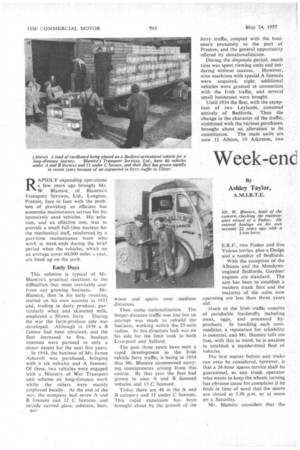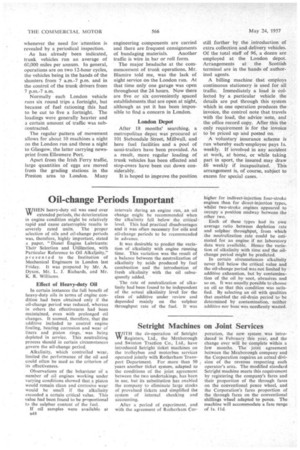Week-end ;ervicing for a Trunk Fleet
Page 84

Page 85

Page 86

If you've noticed an error in this article please click here to report it so we can fix it.
By
Ashley Taylor,
A.M.I.R.T.E. RAPIDLY expanding operations a few years ago brought Mr. W. Blamire, of Blamire's Transport Services, Ltd., Longton, Preston, face to face with the problem of providing an efficient but economic maintenance service for his intensively used vehicles. His solution, and an effective one, was to provide a small full-time nucleus for the mechanical staff, reinforced by a part-time maintenance team who work at week-ends during the brief period when the vehicles, wh:ch on an average cover 60,000 miles a year, are lined up on the park.
Early Days
This solution is typical of Mr. Blamire's practical reactions to the difficulties that must inevitably con front any growing business. Mr. Blamire, then in his early twenties, started on his own account in 1935 and, trading in dairy produce, particularly whey and skimmed milk, employed a 20-cwt. lorry. During the war the farm-produce side was developed. Although in 1939 a B licence had been obtained, and the fleet increased to five, haulage interests were pursued to only a minor extent for the next five years.
In 1944, the business of Mr. James Ashcroft was purchased, bringing with it six vehicles and A licences. Of these, two vehicles were engaged with a Ministry of War Transport unit scheme on long-distance work whilst the others were mainly employed locally. At the end of the war, the company had seven A and B liences and 12 C licences, and mainly carried glass, asbestos, beer,
841'4 wines and spirits over medium distances.
Then came nationalization. The longer-distance traffic was lost but an attempt was made to rebuild the business, working within the 25-mile radius. In this direction luck was on his side for the limit took in both Liverpool and Salford.
The past three years have seen a rapid development in the Irish vehicle ferry traffic, it being in 1954 that Mr. Blamire commenced carrying consignments arising from this source. By that year the fleet had grown to nine A and B licensed vehicles and 15 C licensed.
Today there are 46 in the A and B category and 11 under C licences. This rapid expansion has been brought about by the growth of the ferry traffic, coupled with the business's proximity to the port of Preston, and the general opportunity offered by denationalization.
During the disposals period, much time was spent viewing units and ten dering without success. However, nine machines with special A licences were acquired, eight additional vehicles were granted in connection with the Irish traffic, and several small businesses were bought.
Until 1954 the fleet, with the exception of two Leylands, consisted entirely of Bedfords. Then the ' change in the character of the traffic; combined with the various purchases, brought about an alteration in its constitution. The main units are now 12 Albion, 10 Atkinson, two E.R.F„ two Foden and five Vulcan lorries, plus a Dodge and a number of Bedfords.
With the exception of the Albions and the Meadowsengined Bedfords, Gardner engines are standard. The aim has been to establish a modern trunk fleet and the majority of the units now operating are less than three years old.
Much of the Irish traffic consists of perishable foodstuffs, including meat, eggs, and processed byproducts. In handling such commodities, a reputation for reliability is essential, and Mr. Blamire tells me that, with this in mind, he is anxious to establish a standardized fleet of vehicles.
The first matter before any make can even be considered, however, is that a 24-hour spares service shall be guaranteed, as any. trunk operator who wants to keep the wheels turning has obvious cause for complaint if he finds in time of need that the stores are closed at 5.30 p.m. or at noon on a Saturday.
Mr. Blamire considers that the future of the long-distance haulage industry lies in vehicles operating as economically as possible and at not too great a speed. His experience has shown that faster machines have brought increased operating costs in their train, fuel consumption being poorer, brakes and clutches needing more frequent refacing and there being a greater accident-proneness.
The rapid growth of the business was at first accompanied by a number of difficulties, one of which concerned the evolution of a satisfactory system of maintenance. The fact that the vehicles were largely employed on overnight trunk runs to London and Glasgow meant that the Only time most of the fleet could be assembled was at week-ends. In consequence it was decided that the full-time maintenance staff should be supplemented by part-timers. A little research in this direction resulted in the recruitment of a number of semi-skilled men who were allocated to ' different sections of the work.
Full-time employees on these duties are five fitters and two apprentices. Three of the former take full week-end duty and rotas are arranged so that 24-hour coverage is provided. Two semi-skilled men work on a schedule that ensures that each engine receives a complete sump refill every third week. They also clean the fuel filters and give attention to the batteries once a week.
One man is engaged in washing every cab each week-end so as to ensure as a minimum that each vehicle presents a clean face to the world at the beginning of the week. Another inspects all ,tyres for wear and defects, checks pressures, and inspects wheels and pubs.
A semi-skilled man and a young assistant are engaged for giving the vehicles and articulated semi-trailers monthly greasing. Another semiskilled employee, with an assistant, paints cabs and bodies, a jobbing sign-writer being called in to do the lettering. The whole system obviously produces a satisfactory standard of maintenance at a most reasonable cost.
Individual Reports
During the monthly inspections, the foreman fitter gives a general report to Mr. Blamire on the state of each individual vehicle. From day to day the trunk drivers report to the foreman mechanic details of any faults that have arisen. The foreman, if necessary, immediately consults the traffic office regarding the particular unit's future availability. The length of time elapsing between the various overhauls differs to some extent according to the products carried and type of work on which the individual machines have been employed.
On the average, Gardner engines are given an overhaul annually (at 60,000 miles), with new piston rings every two years. Complete engine overhauls occur at about 180,000200,000 miles. So far as painting is concerned, the vehicles are called in
whenever the need for attention is revealed by a periodical inspection. As has already been indicated, trunk vehicles run an average of 60,000 miles per annum. In general, operations are on two 12-hour cycles, the vehicles being in the hands of the shunters from 7 a.m.-7 p.m. and in the control of the trunk drivers from 7 p.m.-7 a.m.
Normally each London vehicle runs six round trips a fortnight, but because of fuel rationing this had to be cut to five a fortnight. The loadings were generally heavier and a certain amount of traffic was subcontracted.
The regular pattern of movement allows for about 10 machines a night on the London run and three a night to Glasgow, the latter carrying newsprint from Ellesmere Port.
Apart from the Irish Ferry traffic, large quantities of eggs are moved from the grading stations in the Preston area to London. Many engineering components are carried and there are frequent consignments of bandaging materials. Another traffic is wire in bar or roll form.
• The major headache at the commencement of trunk operations, Mr. Blamire told me, was the lack of night service on the London run. At that time only one garage was open throughout the 24 hours. Now there are five or six conveniently spaced establishments that are open at night, although as yet it has been impossible to find it concern in London.
London Depot
After IS months' searching, a metropolitan depot was procured at 101 Stebondale Street, Millwall, and here fuel facilities and a pool of semi-trailers have been provided. As a result, more regular loading of trunk vehicles has been effected and stop-overs have been cut down considerably.
It is hoped to improve the position
still further by the introduction of extra collection and delivery vehicles. Of the total staff of 96, a dozen are employed at the London depot. Arrangements at the Scottish terminal are in the bands of authorized agents.
A billing machine that employs continuous stationery is used for all traffic. Immediately a load is collected by a particular vehicle the details are put through this system which in one operation produces the invoice, the control note that travels with the load, the advice note, and the office record copy. After this the only requirement is nir the invoice to be priced up and posted en.
A voluntary insurance scheme is run whereby each-employee pays Is.• weekly. If involved in any accident at work, at home, or while taking part in sport, the insured may draw £6 weekly if incapacitated. This arrangement is of course, subject to excess for special cases.








































































































































